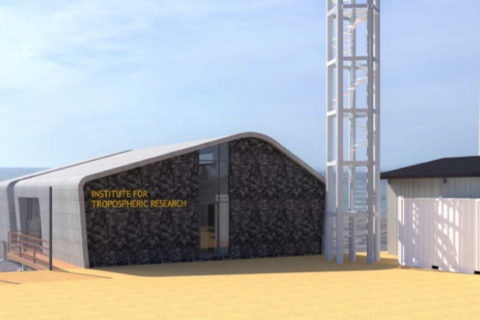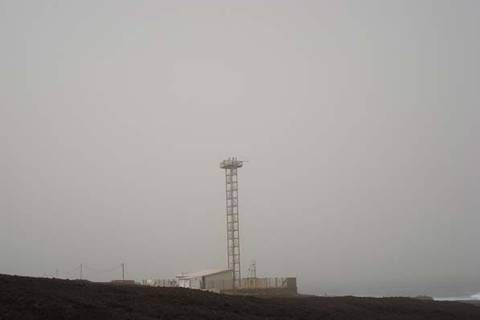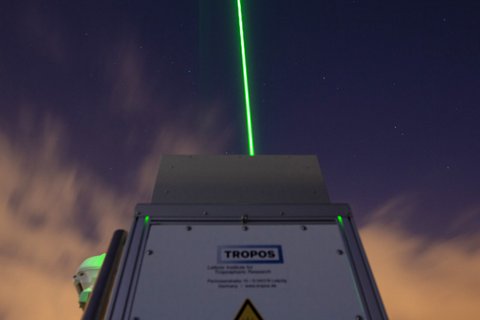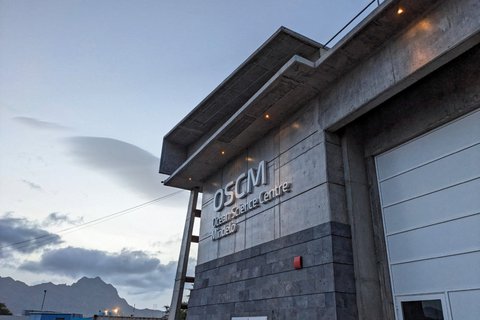The Cape Verde Atmospheric Observatory (CVAO)
The Cape Verde Atmospheric Observatory in the tropical Atlantic studies important aerosol sources of our planet and their influence on health and climate. Thanks to the cooperation with partners in the Republic of Cabo Verde and together with German and British research institutes, TROPOS makes an important contribution to research, teaching and transfer internationally and especially for West Africa.
The Cape Verde Atmospheric Observatory (CVAO) is located on São Vicente, one of the Cape Verde Islands, about 800 km west of the African continent. It was founded in 2007 on the basis of several joint third-party funded projects such as TENATSO (EU infrastructure project) and SOPRAN (BMBF research project) in international cooperation with UK SOLAS (University York), the Max Planck Institute for Biogeochemistry (MPI-BGC) Jena and the Instituto Nacional de Meteorologia e Geofisica (INMG) of the Republic of Cabo Verde.
Since then, air samples have been taken continuously on a 30m tower for chemical and physical characterisation of the background aerosol in the subtropical Atlantic. The location on a cliff near Calhau on the north-eastern tip of the island of São Vicente makes it possible to characterise the background aerosol, as the air there usually comes from the ocean and thus local sources play practically no role. With the prevailing northeast trade wind, air masses from northwest Africa or the northern Atlantic are transported to the CVAO. The measurement programme includes chemical characterisation, measurement of particle number distribution from 0.020 to 10 micrometres, light absorption by particles and measurement of meteorological parameters. During intensive measurement campaigns, additional sampling and measurement methods are used, for example size-selective impactors for a more detailed chemical analysis and the determination of hygroscopic properties.
The aim of all investigations is the long-term recording of the near-surface particle composition and its seasonal and interannual variability in the tropical northeastern Atlantic. The observatory monitors both the continental transport of Saharan dust from northern Africa as well as marine aerosol. For both phenomena, developments over longer periods of time are important in order to be able to reliably characterise developments in the context of global climate change.
Important focal points of detailed investigations are aerosol processing, such as chloride and bromide exchange by nitrate and sulphate, as well as the analysis of Saharan dust including the mobilisation of the contained iron during atmospheric transport. In addition, transition metals are analysed in these samples, which, depending on their bioavailability, are important trace elements for biomass growth in the ocean. Above all, organic trace substances from the ocean (organic surface film) are analysed in the PM1 samples in order to answer open questions about the exchange of trace substances between the ocean and the atmosphere. In the current DUSTRISK project, a networking project funded by the Leibniz Association, health effects of dust exposure of the population are investigated in close cooperation with hospitals on Cape Verde.
The in-situ aerosol measurements at the CVAO are part of the Global Atmosphere Watch (GAW) programme of the World Meteorological Organization (WMO) and aim at a unified, coordinated global understanding of the composition of the atmosphere and its changes. The measurements also contribute to a better understanding of the interactions between the atmosphere, the oceans and the biosphere. Quality assurance of the measurement data is carried out by international calibration centres, such as the World Calibration Center for Aerosol Physics (WCCAP), which TROPOS in Leipzig operates for the WMO and the Federal Environment Agency, also in the GAW programme.
The in-situ aerosol measurements at the CVAO tower are complemented by extensive remote sensing of the vertical profiles of aerosols and clouds as well as radiation balance measurements at the site of the partner institute Ocean Science Center Mindelo (OSCM) of the Helmholtz Centre for Ocean Research (GEOMAR). For this purpose, a lidar system developed at TROPOS has already been installed and has been in permanent use since 2021. Since 2023, this has been supplemented by radar and microwave radiometers and accompanied by satellite remote sensing and modelling in order to obtain as complete a picture as possible of the aerosol and its interaction with clouds and radiation in the coupled atmosphere/ocean/land system. The remote sensing station at OSCM also plays an important role in the validation of Earth observation satellites such as METEOSAT and was, among other things, the focal point of the ESA-led "Aeolus Tropical Atlantic Campaign" (ASKOS) in support of the Aeolus wind and aerosol lidar mission.
Thanks to the funding of research infrastructures with the ACTRIS-D project of the BMBF's National Roadmap, the German share of the CVAO observatory can now be renewed and expanded. A photovoltaic system and a new research building will be constructed for this purpose. The research building will significantly improve the working possibilities at the CVAO in the very near future and thus lay the foundation for the continuation of the complex time series investigations at the CVAO for the next two decades.


















